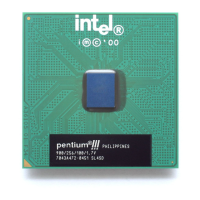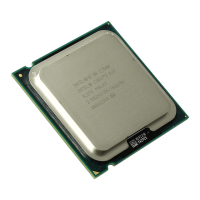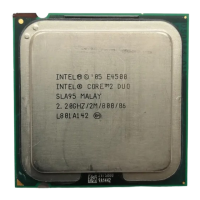
Do you have a question about the Intel E2180 - Pentium Dual-Core 2.00GHz 800MHz 1MB Socket 775 CPU and is the answer not in the manual?
| Clock Speed | 2.00GHz |
|---|---|
| FSB Speed | 800MHz |
| L2 Cache | 1MB |
| Socket | LGA 775 |
| Number of Cores | 2 |
| TDP | 65W |
| Manufacturing Technology | 65nm |
| Number of Threads | 2 |
| Virtualization Technology | No |
| Integrated Graphics | No |
| Processor Model | Intel Pentium Dual-Core E2180 |
Details mechanical specifications for processor packages, including IHS, socket interface, and heatsink attach.
Defines processor thermal limits, thermal profile as a function of power, and TCONTROL specifications.
Covers factors like heat transfer area, conduction path, and convective heat transfer conditions for heatsink design.
Explains thermal characterization parameters (Psi) and their calculation for overall thermal solution performance.
Provides instructions for accurately measuring local ambient temperature (TA) for thermal testing.
Details procedures for accurate measurement of processor case temperature (TC) using thermocouples.
Describes the on-die thermal monitor, including PROCHOT#, TCC, TM2, operation, and DTS.
Covers structural reliability tests like vibration, shock, and power cycling for BTX thermal solutions.
Details safety standards like UL, CSA certifications, and sharp edge requirements for BTX thermal components.
Discusses structural design strategy, preload limits, and stiffness for BTX Thermal Module Assemblies.
Documents requirements for active air-cooled ATX designs with fan-top heatsinks and thermal technology.
Presents heatsink performance and acoustic results for ATX reference designs based on test procedures.
Covers structural reliability tests like vibration, shock, and power cycling for ATX thermal solutions.
Details safety standards like UL, CSA certifications, and sharp edge requirements for ATX thermal components.
Explains the QST algorithm using PID control and weighting matrix for fan speed optimization.
Discusses heatsink clip load for mechanical performance, vibration resistance, and thermal interface.
Discusses gap management between IHS and heatsink base for optimal thermal performance.
Covers material thermal resistance and wetting/filling characteristics for interface performance.
Recommends calibration of measurement equipment against known standards for accurate temperature readings.
Provides a step-by-step guide for attaching a thermocouple to the IHS using solder.
Emphasizes selecting a thermal solution that meets the processor's thermal profile for effective fan speed control.












